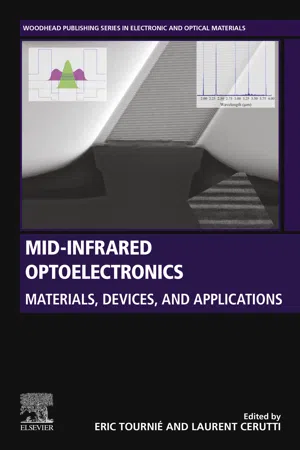
Mid-infrared Optoelectronics
Materials, Devices, and Applications
Eric Tournié,Laurent Cerutti
- 750 pages
- English
- ePUB (mobile friendly)
- Available on iOS & Android
Mid-infrared Optoelectronics
Materials, Devices, and Applications
Eric Tournié,Laurent Cerutti
About This Book
Mid-infrared Optoelectronics: Materials, Devices, and Applications addresses the new materials, devices and applications that have emerged over the last decade, along with exciting areas of research. Sections cover fundamentals, light sources, photodetectors, new approaches, and the application of mid-IR devices, with sections discussing LEDs, laser diodes, and quantum cascade lasers, mid-infrared optoelectronics, emerging research areas, dilute bismide and nitride alloys, Group-IV materials, gallium nitride heterostructures, and new nonlinear materials. Finally, the most relevant applications of mid-infrared devices are reviewed in industry, gas sensing, spectroscopy, and imaging.
This book presents a key reference for materials scientists, engineers and professionals working in R&D in the area of semiconductors and optoelectronics.
- Provides a comprehensive overview of mid-infrared photodetectors and light sources and the latest materials and devices
- Reviews emerging areas of research in the field of mid-infrared optoelectronics, including new materials, such as wide bandgap materials, chalcogenides and new approaches, like heterogeneous integration
- Includes information on the most relevant applications in industry, like gas sensing, spectroscopy and imaging
Frequently asked questions
Information
The physics of mid-infrared semiconductor materials and heterostructures
Abstract
Keywords
Acknowledgments
1.1 Introduction
